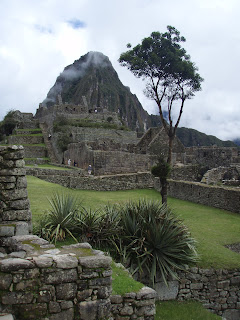Pisac in the Sacred Valley
As we came down into the Sacred Valley we passed through
Ollantaytambo (which is described as 'a living Inca town' where the Quechua Indians have maintained the Inca traditions), and visited the Inca ruins at Pisac
terracing at Pisac
sameagain, Pisac ...
 | |||||||||||||
| The rough terraces, centre, were pre-Inca. Those on the right, Inca. |
The Inca terraces were much more skilfully designed and built. Each terrace had layers of coarse rock/boulders, with grit, sand and soil graded towards the surface. This meant there was no leaching of the invaluable finest fertile soil during the rainy season - it merely got flushed onto the next terrace, if at all. Presumably all they had to do was dress the top-most terraces with new soil each year.
A lot of these terraces are full of flowers, mostly dahlias.
Climbing up takes the breath away, in more than one sense of the word :)
This is a vicuna (vicunya) - the smallest of the camelids (llama, alpaca etc).
It produces the finest and softest hair for textiles which are extremely expensive.
One very nearly bit me!
same
Looking back across the valley:
1.Centre, just left of thatch roof - granary store on the mountainside.
2.Left of granary - face of a mountain-god whom the Incas worshiped - if you zoom right in, you can just make out his crown - a turreted building directly above his forehead.
3.Left of the face on the further slope is another building, thought to be a temple as there was no trace of it being another granary.
And below, a few more pics of Machu Picchu which we visited the next day:
If you look at the rock face of Huayna Picchu, the backdrop, you can just make out (with a little imagination!) the image of a Puma, one of the Incas' three chief gods.
The Royal Sector, far left, with the Temple of the Sun (the lighter coloured building) - very fine stonework which was originally covered in sheet-gold. The gold had been taken long before Machu Picchu was re-discovered in the early 1900's. The Temple of the Condor is right of centre.
The flame tree
Beneath the Temple of the Sun - spot the chinchilla which lives in there!
(you can only see his feet)
Window for the Solstices - aligned with the summer and winter solstices.
The Serpent Window - this window was used to introduce snakes, according
to our guidebook: presumably for ceremonial purposes.
Temple of the Sun - fine stonework, much of it carved from the resident rock.


















No comments:
Post a Comment